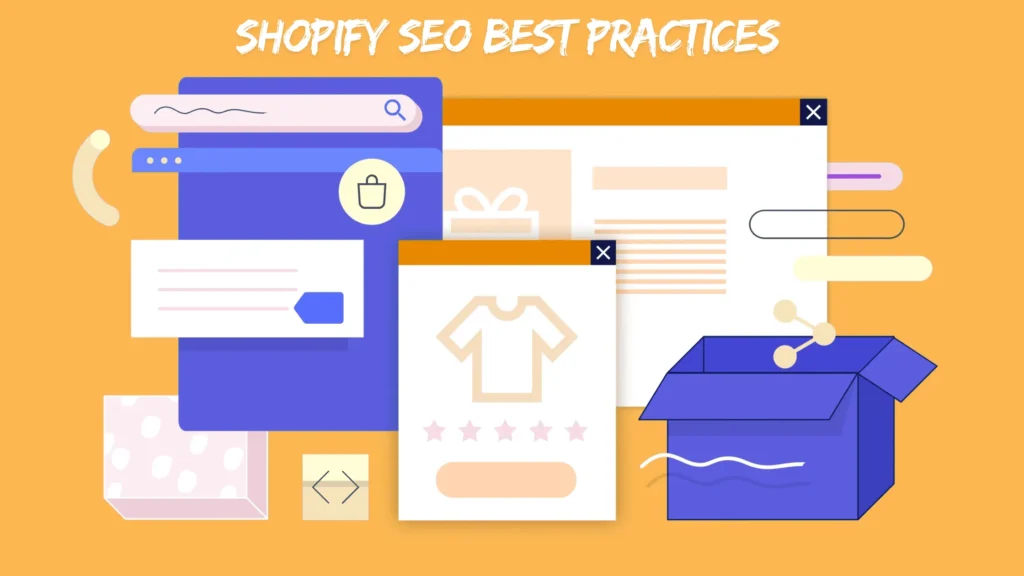Running an online store needs more than a good website. You must also grasp SEO (Search Engine Optimization) to boost traffic and sales. Shopify SEO helps your store rank higher in search results. This way, you can reach potential customers better. In this guide, we’ll explore Shopify SEO best practices. These tips will help you optimize your store. Better SEO means more visibility and improved performance for your shop. Whether you’re a beginner or a seasoned store owner, these tips will guide you to success.
Shopify SEO Basics
Before diving into advanced techniques, it’s important to understand the SEO basics for Shopify. Shopify offers built-in SEO features that make optimizing your store easier. However, mastering Shopify SEO basics is essential to ensure you’re setting the foundation for long-term success.
Understanding SEO for Shopify
SEO for Shopify refers to the optimization of your online store to ensure it ranks higher in search engine results like Google. Focusing on on-page and technical SEO helps search engines grasp your store and content. This, in turn, boosts its ranking. Shopify SEO is designed to help store owners enhance the visibility of their products, pages, and content.
Key Factors That Impact Shopify SEO
There are several factors that impact Shopify SEO, including:
- Product Page Optimization – Each product page is an opportunity to optimize your store and improve SEO for Shopify. The product title, description, and images all need to be optimized with the right keywords to improve visibility.
- Meta Descriptions and Title Tags – These are essential for both on-page SEO and improving click-through rates from search results.
- SEO-Friendly URLs – Shopify allows you to create SEO-friendly URLs that are clean and keyword-rich, making it easier for search engines to understand the content of the page.
- Mobile Optimization – Shopify stores are generally considered good for SEO, especially because they are mobile-friendly, which is crucial as search engines prioritize mobile-first indexing.
What Makes Shopify SEO Different from Other Platforms?
Shopify is a top eCommerce platform. It’s great for SEO because it has built-in features. You can customize meta tags and use SEO-friendly URLs. These features make it easier for Shopify store owners to rank higher in search engines. Unlike other platforms that may require extensive plugins, Shopify offers SEO optimization options within its admin panel and apps, making it user-friendly for beginners.
On-Page SEO for Shopify

On-page SEO is a crucial element for optimizing your Shopify store. It involves making changes directly on your site to improve its ranking in search engines. This includes optimizing the content on your website, product pages, meta descriptions, and more.
Optimizing Your Shopify Product Pages for SEO
Optimizing your Shopify product pages is one of the most important SEO practices. Ensure that each product page is unique and contains high-quality content. Use keywords naturally within your product descriptions, titles, and URLs. Optimizing images with alt text and file names will also help improve SEO.
The Importance of Meta Descriptions and Title Tags
Meta descriptions and title tags are critical for Shopify SEO. These elements appear in search engine results and provide a brief overview of what users can expect from your page. An SEO-friendly title tag should include relevant keywords, while a compelling meta description can encourage users to click on your store link.
Using SEO-Friendly URLs in Shopify
Creating SEO-friendly URLs is an important part of Shopify SEO. Keep URLs short, descriptive, and keyword-rich. Shopify automatically generates URLs based on product titles, but you should ensure that they are optimized for better indexing by search engines.
Implementing High-Quality Product Descriptions
High-quality product descriptions are vital for both SEO and user experience. Write clear and brief descriptions. Focus on keywords that highlight the product’s features, benefits, and uses. Avoid generic or duplicated content, as unique product descriptions are essential for better ranking.
Shopify SEO Optimization Tips
Now that you understand the basics, let’s dive into some advanced Shopify SEO optimization tips to take your store to the next level.
How to Improve Shopify SEO with Effective Keyword Research
Effective keyword research is essential for improving SEO on Shopify. Use keyword research tools like Google Keyword Planner or a free tool from Shopify’s app store to identify high-volume, relevant keywords. Ensure you are targeting both short-tail and long-tail keywords related to your products.
Shopify SEO Best Practices for Image Optimization
Images play a huge role in SEO. Compress images to improve site speed and make sure that each image has descriptive alt text. This not only improves the user experience but also contributes to better SEO by helping search engines understand what each image represents.
Leveraging Internal Linking for Better SEO
Internal linking is a great way to improve SEO for Shopify. Link related products, blog posts, and pages to help search engines understand the structure of your store. This also helps visitors navigate your site more easily and encourages them to spend more time browsing.
Optimizing Your Shopify Store for Mobile SEO
With mobile searches becoming more prevalent, optimizing your Shopify store for mobile is crucial for SEO success. Ensure your theme is mobile-responsive and that your content is easily accessible on mobile devices. Mobile optimization is not only important for SEO but also for providing a better user experience.
Technical SEO for Shopify

While on-page SEO is important, technical SEO is the backbone of a successful Shopify SEO strategy. It ensures that your store’s infrastructure is search-engine-friendly, improving indexing and ranking.
Fixing Crawl Errors and Ensuring Proper Indexing
Crawl errors can prevent search engines from properly indexing your store, which could harm your rankings. Use tools like Google Search Console to identify and fix crawl errors. Ensuring proper indexing of your pages is essential for good SEO performance.
Speed Optimization Tips for Shopify SEO
Website speed is a crucial factor for both SEO and user experience. A slow-loading Shopify store can hurt your rankings and drive visitors away. Optimize your Shopify store’s speed by compressing images, using a content delivery network (CDN), and choosing a fast Shopify theme.
Optimizing Site Structure for SEO
A well-organized site structure helps both users and search engines navigate your Shopify store easily. Organize your products into clear categories and subcategories. Also, ensure important pages are easy to reach within just a few clicks.
Implementing Structured Data and Schema Markup
Using schema markup (structured data) on your Shopify store can help search engines understand the content of your pages better. This can lead to rich snippets in search results, which can improve click-through rates and visibility. Shopify provides built-in SEO features that support structured data for better indexing.
Shopify SEO Tools and Resources
To ensure ongoing success, it’s important to use the right SEO tools. Shopify has several apps and tools that can help you optimize your store for better SEO performance.
The Best SEO Tools for Shopify Store Owners
Shopify offers a variety of SEO apps that can help improve your store’s SEO. Some popular tools include:
- SEO Manager: A powerful Shopify app that offers an easy way to manage SEO elements like meta tags, titles, and URLs.
- Smart SEO: This tool automatically generates meta tags, alt text, and other SEO-friendly elements.
- Plug in SEO: A great app to perform SEO audits and optimize your Shopify store.
Using Shopify Apps to Improve SEO
Shopify SEO apps are an excellent way to manage your store’s SEO needs. These apps can automate many aspects of SEO, like optimizing meta tags, improving image alt text, and running SEO audits. Using apps like Shopify Magic can help optimize your store’s SEO effortlessly.
How to Track SEO Performance for Your Shopify Store
Tracking your SEO performance is key to understanding how well your optimization efforts are working. Use Shopify’s analytics tools or add Google Analytics to track your SEO performance. Regularly checking SEO performance ensures that you can adjust your strategies for continuous improvement.
Also Read: Affordable Shopify SEO Services That Skyrocket Sales!
Keeping Your Shopify Store SEO-Optimized for Success
With a strong understanding of Shopify SEO best practices, you’re now equipped to optimize every part of your Shopify store. Using the right strategies helps your store rank well in search engines. This attracts more organic traffic and boosts sales. Shopify helps store owners harness SEO with its built-in features. However, lasting success comes from ongoing optimization and improvement.
Follow this guide to improve your store’s SEO. Start with keyword research. Then, optimize your product pages. Use the right Shopify SEO tools. Over time, these steps will boost your SEO performance. No matter if you’re new to Shopify or improving your SEO, each step helps you reach your business goals.
Don’t forget, Shopify also provides a variety of apps and tools that can simplify the process, such as Shopify Magic and SEO Manager. These tools help automate and simplify your SEO tasks. This way, you can spend more time on your business and less on the details. A strong SEO strategy helps your Shopify store rank higher in search results. This boosts visibility and can increase your profits.
